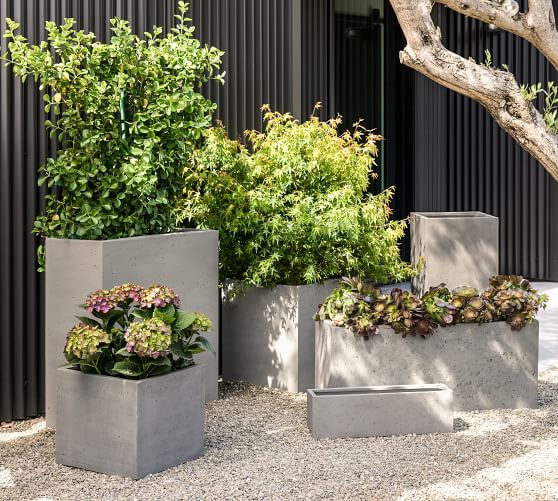When it comes to beautifying our outdoor spaces, decorative yard planters can serve as the perfect solution. Not only do they add a splash of color and style, but they also provide a functional way to grow your favorite plants. With my experience in gardening and outdoor aesthetics, I’ve found that the right planters can transform even the simplest yards into tranquil havens. In this comprehensive guide, we will explore the various types, benefits, and tips for choosing the best decorative planters for your yard.
What Are Decorative Yard Planters?
Decorative yard planters are containers used for planting flowers, herbs, and other plants while enhancing the visual appeal of outdoor spaces. They come in various materials, sizes, and designs, allowing homeowners to select options that suit their personal style and landscaping needs.
Popular Materials for Decorative Yard Planters
- Wood: Often used for raised garden beds; offers a rustic charm.
- Ceramic: Available in multiple colors and designs; adds elegance.
- Metal: Durable and modern; great for industrial-themed gardens.
- Plastic: Lightweight and versatile; ideal for easy mobility.
Benefits of Using Decorative Yard Planters
Decorative planters offer numerous benefits that go beyond aesthetics. Here are some reasons to incorporate them into your garden:
1. Enhanced Aesthetics
Decorative planters can instantly elevate the look of any yard. Their unique designs and vibrant colors create visual interest.
2. Versatility
From small apartment balconies to sprawling gardens, decorative planters come in a range of sizes to fit any space.

3. Improved Plant Health
High-quality planters often provide better drainage and aeration, promoting healthier root systems.
4. Mobility
Many decorative planters are lightweight, allowing you to rearrange your garden design with ease.

Choosing the Right Decorative Yard Planters
With so many options available, selecting the right decorative planters can be daunting. Here are some key factors to consider:
1. Size and Scale
Consider the size of your plants and the space they will occupy.

Size Comparison Table
| Size | Recommended Plants | Best Locations |
|---|---|---|
| Small (6-12 inches) | Succulents, Herbs | Patios, Windowsills |
| Medium (12-24 inches) | Annuals, Small Perennials | Garden Borders, Entryways |
| Large (24+ inches) | Small Trees, Large Shrubs | Gardens, Focal Points |
2. Style and Design
Choose decorative planters that complement your home’s architectural style and your personal aesthetic. Options range from classic terracotta to modern geometric designs.

3. Drainage
Ensure your planters have proper drainage holes to prevent waterlogging and root rot.
Types of Decorative Yard Planters
Here’s a breakdown of the most popular types of decorative yard planters:
.jpg)
1. Raised Garden Beds
These large planters allow for greater control over soil quality and drainage. They are ideal for growing vegetables and flowers.
2. Window Boxes
Perfect for adding greenery to window sills, window boxes can be filled with vibrant flowering plants or trailing vines.

3. Hanging Planters
These are great for saving space and creating a unique visual display. Consider using them with trailing plants for a dramatic effect.
4. Urns
Urns add a touch of elegance to your garden and work well as focal points. They are commonly used for larger plants or topiaries.
Decorative Planter Trends
Staying up-to-date with current trends can inspire your planting choices. Here are some popular trends in decorative yard planters:
1. Eco-Friendly Materials
More gardeners are opting for sustainable materials such as recycled plastic or reclaimed wood.
2. Vertical Gardens
Utilizing wall-mounted planters helps maximize space, especially in smaller yards and balconies.
3. Mixed Material Planters
Combining different materials (like wood and metal) can create a unique and eye-catching planter.
Personal Experience: My Journey with Decorative Planters
Starting my gardening journey, I was overwhelmed by the choices available. I remember my first decorative planter—a classic terracotta pot—filled with vibrant marigolds. It was simple, but the joy it brought me inspired me to experiment more. Over the years, I’ve expanded my collection, and I’ve learned that the key to a stunning garden is diversity in design and color.
Pros and Cons of Decorative Yard Planters
Pros
- Beautifully enhances your outdoor space.
- Allows for better plant management and care.
- Can be tailored to fit any design aesthetic.
Cons
- Some materials require more maintenance (e.g., wood).
- Initial investment can be higher compared to direct planting.
Care Tips for Decorative Yard Planters
To ensure your decorative planters thrive, follow these care tips:
1. Watering
Monitor your plants regularly and water according to their needs. Always check the soil moisture before watering.
2. Fertilizing
Use the right type of fertilizer to provide essential nutrients, especially during the growing season.
3. Seasonal Maintenance
Change plants according to the seasons and clean your planters to prevent any buildup of algae or pests.
FAQs About Decorative Yard Planters
What are the best plants for decorative planters?
Some popular choices include petunias, geraniums, and ornamental grasses. Consider the sunlight and climate of your area for the best selection.
How do I prevent my planters from tipping over?
Choose heavier materials, or use a stabilizing base like a concrete block. Additionally, ensure the planter is sufficiently filled with soil and plants.
Can I use indoor planters outdoors?
It’s best to use planters specifically designed for outdoor use, as indoor planters may not withstand weather conditions.
What is the best height for a planter?
The ideal height depends on the plants you’re growing. Taller plants generally require deeper planters, while shorter plants can thrive in shallower containers.
Do decorative planters need saucers?
Saucers help catch excess water and prevent mess on surfaces below. They are especially useful for indoor planters.
Conclusion
Decorative yard planters are more than just containers; they are a vital part of landscape design that enhances the beauty of your garden. By carefully selecting the right planters and plants, you can create a stunning outdoor space that reflects your personal style. Embrace the joy of gardening with decorative planters, and watch your outdoor area transform into a beautiful retreat.